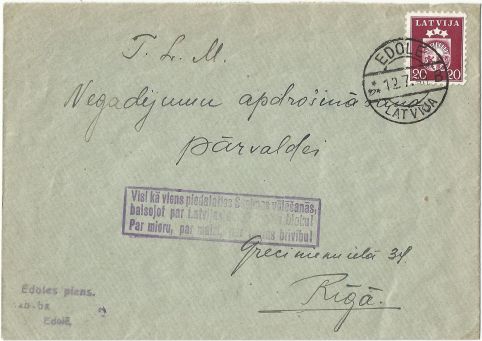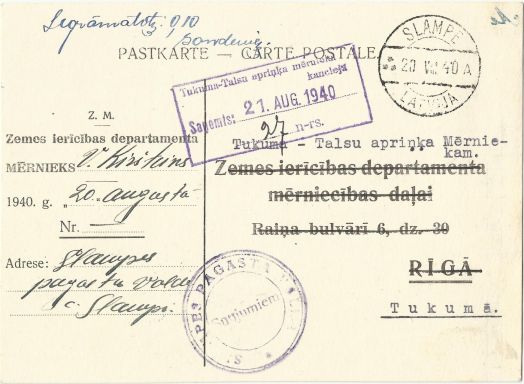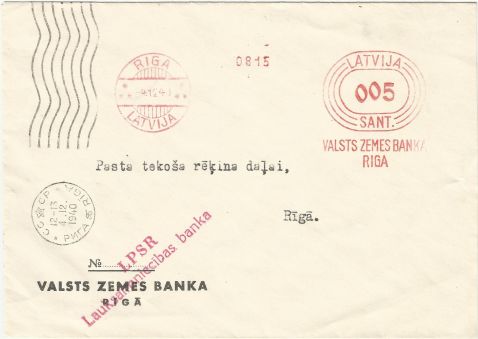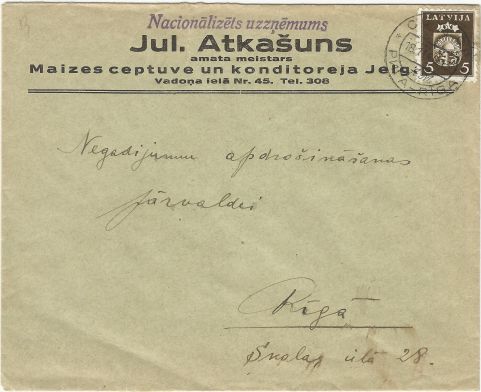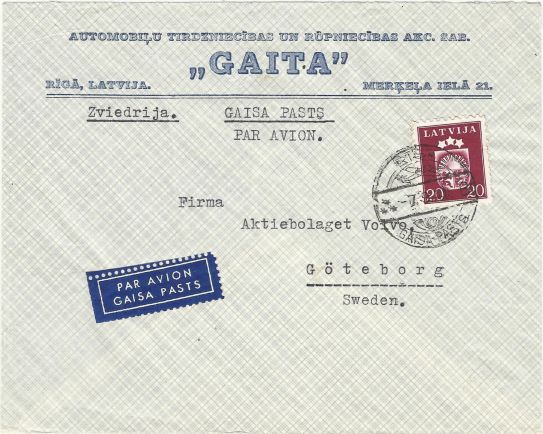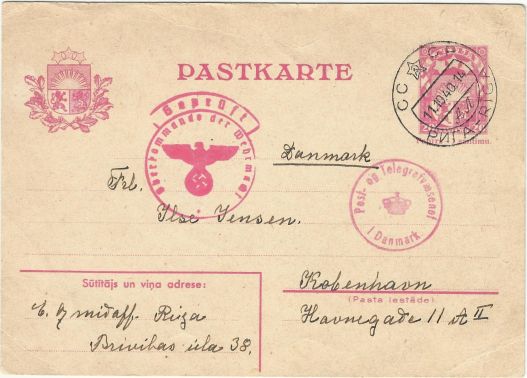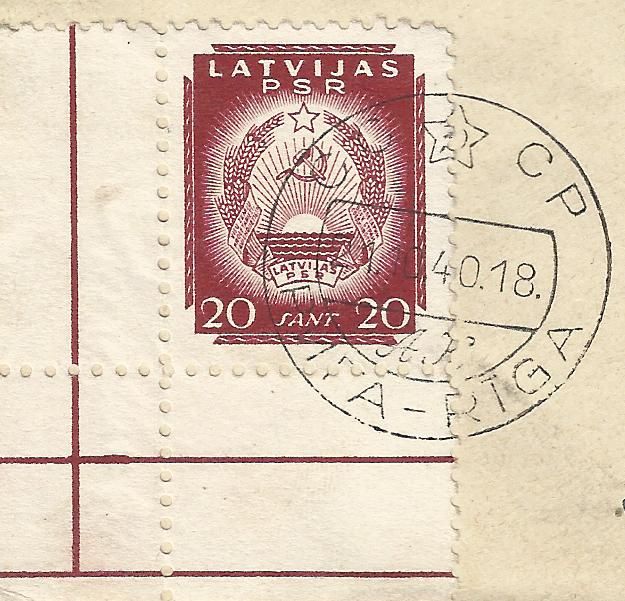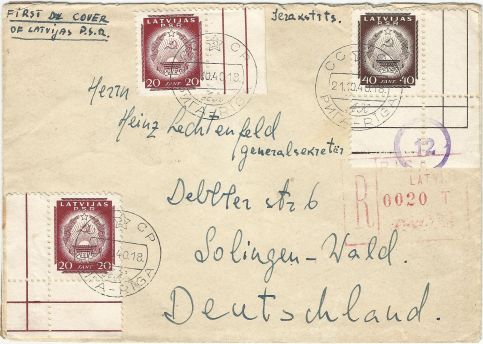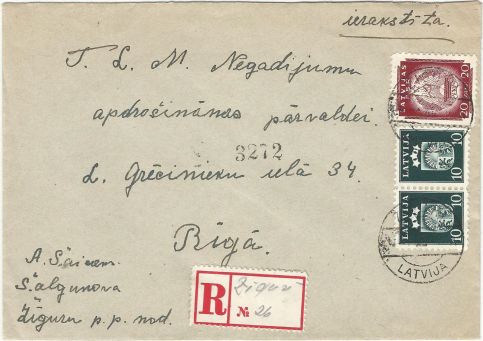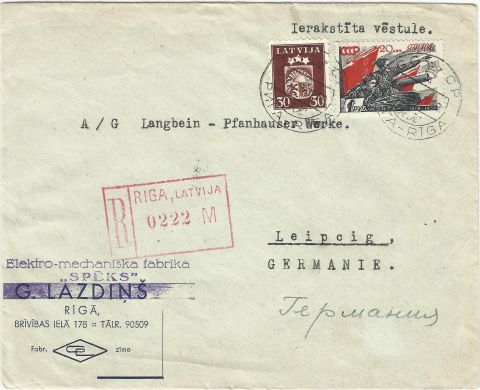Latvia
-
Courland, Semigallia, Latgale
-
Royal Swedish Post
-
Imperial Russian Post
-
German Occupation / Ob. Ost
-
Independent Republic of Latvia
-
Soviet occupation
First Soviet occupation 1940–1941
On June 17, 1940, units of the Red Army occupied Latvia. Just three days later, the Soviets announced the formation of a so-called " People' s Government" under Augusts Kirhenšteins.
Mock elections for parliament were held on July 14 and 15, 1940, with bourgeois politicians not allowed to vote.
With a turnout of 94.7 per cent and 97.6 per cent of the votes for the communist unity list, Moscow got the desired result.
President Karlis Ulmanis resigned from office on July 21, 1940 under Soviet pressure. He was later deported to the interior of the Soviet Union, where he died in 1942. The new government proclaimed the establishment of the Latvian Soviet Republic (Latvijas Padomju Sociālistikā Republika) and asked for accession to the USSR, which took place on August 5, 1940 as the 15th Union Republic.
From the beginning and at a high speed, Latvia was sovietised, i.e. the political, administrative, social, economic and cultural conditions were adapted to the communist system of the Soviet Union. A large number of leading bourgeois politicians, the military and economists were arrested and deported.
Farmland, banks, businesses and trading companies were nationalised. On November 25, 1940, the Soviets initially introduced the ruble alongside the Lat at a ratio of 1:1, before the Latvian currency was completely withdrawn from circulation on March 25, 1941. Until then, the deliberately low exchange rate of 1:1 between the lats and the ruble had led to a sell-out of Latvian goods and commodities to the Soviet Union.
Sovietisation of the Latvian Post
Initially, customers of the Post noticed few changes: Latvian stamps, as far as they did not remind of the Ulmanis era, could still be used. The stamps were cancelled with Latvian postmarks and postal rates also remained as they were. For the time being ...
On October 21, 1940, the first two values of 20 and 40 Santīmu appeared with the Sovietised country name "Latvijas PSR" and the new national coat of arms of the Latvian SSR. Another eleven values followed until December 4.
Latvian stamps remained valid for the time being.
In the first week of October, bilingual Soviet postmarks were used in Riga for the first time. They show the Cyrillic abbreviation CCCP (SSSR) and the Soviet star with hammer and sickle at the top. The place name was indicated in both Cyrillic and Latin letters.
On December 15, 1940, the postal tariffs changed partially. For mail to the Soviet Union and abroad, the USSR rates now applied, while within Latvia the previous Latvian rates continued to apply. But only for a short time: from January 20, 1941, the USSR postage rates were generally applied.

Russian postal stationery from ДАУГАВПИЛС – DAUGAVPILS to Sventē, June 24, 1941; in the sender's text: "Daugavpils was bombed today...."
In connection with the tariff change of December 15, 1940, the stamps of the USSR also became valid for franking. Because the Latvian stamps were not withdrawn from circulation until March 21, 1941, stamps of the Republic of Latvia, the Latvian SSR and the Soviet Union could be used simultaneously for over three months.
The first period of Soviet occupation of Latvia in 1940–1941 ended with the occupation by German troops in July 1941 and the subsequent establishment of the General District of Latvia in the Reichskommissariat Ostland, see there.
From mid-July 1944, Soviet troops again occupied parts of Latvia, starting with Latgale in the east and followed by Livonia (in September). Courland remained under German occupation until the surrender of the German Empire on May 8, 1945, see there, before Latvia was completely reincorporated into the Soviet Union as "Latvijas PSR".
Second Soviet occupation 1944–1991
The Sovietisation of Latvia, interrupted by the German occupation, continued massively from 1944/45. New deportations, the collectivisation of agriculture and the industrialisation with the constant settlement of Russians and citizens from other regions of the USSR threatened to turn the Latvian population into a minority in their own country. In 1935, 77% Latvians and 8.8% Russians lived in the Republic of Latvia, whereas in 1989 there were only 52% Latvians and 34% Russians in the Latvian Soviet Republic.
On March 11, 1985, Mikhail Gorbachev was elected General Secretary of the Communist Party of the USSR. By means of "glasnost" and "perestroika" (publicity and reconstruction, ed.) he wanted to bring about structural changes in Soviet society. However, this process led to the dissolution of the Soviet Union at the end of 1991.
In October 1988, the Latvian People's Front (Latvijas tautas fronte) was founded, which initially only demanded cultural and economic autonomy within the Soviet Union. In the elections to the USSR People's Congress in March 1989, it received the majority of Latvian mandates for the first time.
On August 23, 1989, more than one million Estonians, Latvians and Lithuanians formed a chain of people from Tallinn to Riga to Vilnius, the "Baltic Way", to demonstrate their urge for freedom and independence now from the Soviet Union. After the election to the Latvian Supreme Soviet, the Popular Front declared the restoration of the independence of the Republic of Latvia on May 4, 1990, which was acknowledged by the Soviet Union on August 21, 1991.
Although the Latvian SSR was fully integrated into the postal system of the USSR, collectors will also find items of postal history interest in this period. Here are a few examples:
Red Army field postcard from the years 1944–1946
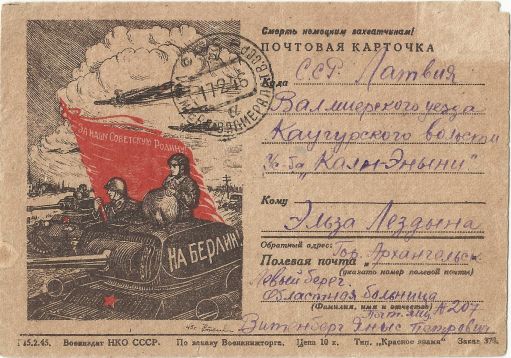
Field postcard of Latvian Janis Witenberg in Arkhangelsk to Valmiera, February 17, 1946; bilingual arrival postmark VALMIERA – ВАЛМЕРА ЛАТВ.С:СР
Further used Latvian postmarks 1944–1948
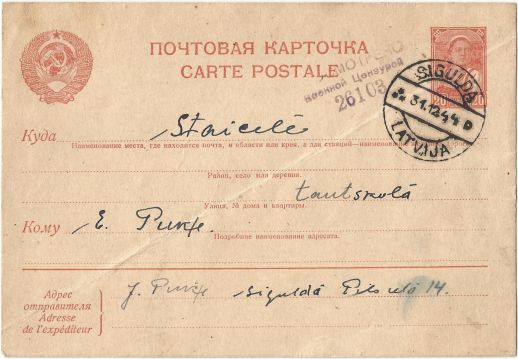
Postal stationary from Sigulda to Staicelē, December 31, 1944; war censor 26103
Aptated postmarks 1944–1945

Latvian tourist picture postcard from Riga-9 to Kauguri, May 6, 1945
The originally bilingual Latvian-Russian postmark had the place name РИГА, the abbreviation CCCP and the Soviet stars with hammer and sickle removed during the German occupation.
On the map it says "Apcelo dzimto zemi", "Travel to your homeland", which obviously did not bother the Soviet war censor 26069.Bilingual railway postmarks

Picture postcard from Alsunga to Strazde, June 17 - 20, 1951 The card was posted at Alsunga railway station on the Liepāja - Ventspils postal wagon.
The stamp was cancelled in the postal wagon with the postmark “П.В. Б/N ЛИЕПАЯ – ВЁНТСПИЛС P.V. B/N LIEPĀJA – VENTSPILS".
Mail of deported Latvians
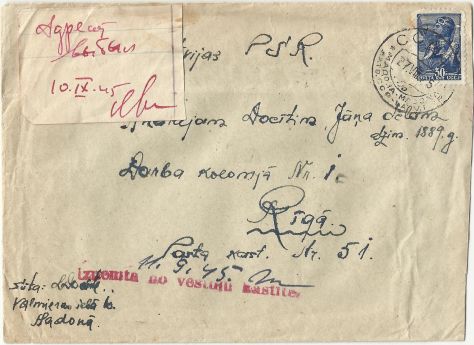
Letter from his family in Madona to Andrejs Docītim in the "Darba kolonija Nr. 1c" (Work Colony No. 1c) in Riga. On the slip at the top left it was noted that the addressee had left. For return, the letter was thrown back into the letterbox and stamped with the postmark "Iznemta no vēstulu kastite" ("From the letterbox"). On September 14, 1945, the letter arrived again at the sender in Madona.
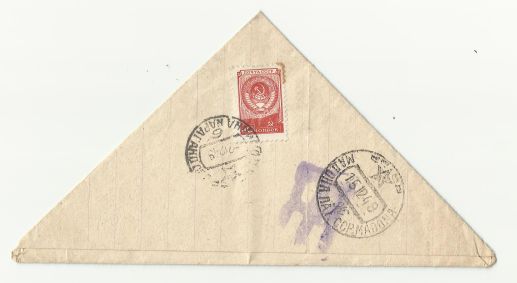
Censored letter from Andrejs Docītim with postmark "Dolinka Karagand" to his family in Madona, December 2 –15, 1949.
The fate behind it: Andrejs Docītim was arrested on December 27, 1944, in his official flat on the Plavinas-Gulbene railway line, accused of anti-Soviet activities. On August 25, 1945, he was deported to the "Karlag", the camp complex around Karaganda in Kazakhstan, where he arrived on September 19. He wrote his first letter to his family in Madona on October 15, 1945. After six years of imprisonment, he was released and could return to Madona.
Postal stationery with Latvian motifs, 1954–1991

Picture envelope from Liepāja to Riga, April 19, 1968; depicted is the Powder Tower in Riga.
Special postmarks and envelopes
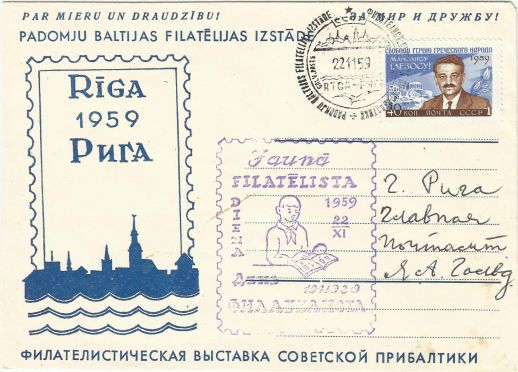
Local cover with special cancel and vignette of the Baltic Stamp Exhibition in Riga, 1959
-
German Occupation / Ostland / Courland
-
Camp Mail / Latvians in Exile
-
Independent Republic of Latvia (restored)
-
Private Mail in Latvia


